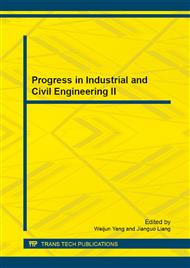p.587
p.595
p.602
p.607
p.611
p.617
p.621
p.633
p.638
The Wing Crack Growth Processes of Rock Induced by Hydraulic Pressure
Abstract:
The pre-existing fractures in rock can close, open and growth as it subjected to mechanical or environment loading, which can in turn change the structure of the rock and alter its fluid flow properties. In order to study the crack growth processes of pre-existing fracture in rock under the condition of hydraulic and mechanical coupling, a numerical tool, named F-RFPA2D which takes into account the growth of existing fractures and the formation of new fractures, is used for this purpose. By considering the effect of hydraulic pressure filling into the wing crack, the behavior of fluid flow, damage evolution and their coupling action in the pre-existing and the newly formed fractures are studied in detail. The modeling results suggest that the hydraulic pressure in the crack enhanced the tensile stresses at the crack tips, resulting in crack growth path is different from that without hydraulic pressure loading. The wing crack growth mechanism under the coupling of hydraulic and mechanical is discussed, which provides a good reference for studying on the hydraulic fracturing in rock masses.
Info:
Periodical:
Pages:
611-616
Citation:
Online since:
September 2013
Authors:
Keywords:
Price:
Сopyright:
© 2013 Trans Tech Publications Ltd. All Rights Reserved
Share:
Citation:


